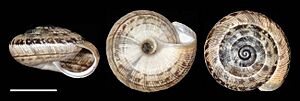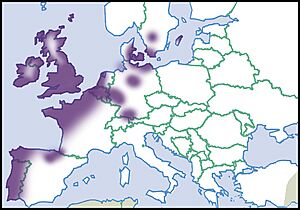Xeroplexa intersecta facts for kids
Xeroplexa intersecta is a small, air-breathing land snail. It's a type of mollusk that lives on land and belongs to the family Geomitridae.
This snail was once known by a different name, Candidula intersecta, but scientists later moved it to the genus Xeroplexa. Sometimes, this snail can cause problems for farmers because it can become a pest in farm areas.
Quick facts for kids Xeroplexa intersecta |
|
|---|---|
 |
|
| Xeroplexa intersecta shells | |
| Conservation status | |
| Scientific classification | |
| Genus: |
Xeroplexa
|
| Species: |
intersecta
|
What Does It Look Like?
The shell of the Xeroplexa intersecta snail is usually between 4 to 7 millimeters tall and 7 to 12 millimeters wide. It has about 5 rounded turns, called whorls, that spiral around.
The opening of the shell, called the aperture, is simple and doesn't have a thick edge or "lip." Near the center of the shell's underside, there's an open hole called the umbilicus, which can be wide or narrow.
The outer layer of the shell, known as the periostracum, is usually whitish or yellowish. It often has brown stripes or spots and tiny lines. The snail's body itself can be yellowish or bluish-grey with dark brown markings. It has two long upper tentacles and two very short lower tentacles on its head.
Where Does It Live?
This snail is originally from parts of Central and Western Europe. You can find it naturally in many countries and islands, including:
- Great Britain
- Ireland
- France
- Portugal
- Belgium
- Netherlands
- Denmark
- Spain
- Germany
Xeroplexa intersecta has also traveled to other parts of the world and now lives there as an introduced species. This means it was brought to these places by people, often by accident. Some of these new homes include:
- Oregon, United States
- Colombia
- Chile
- New Zealand
- Australia




